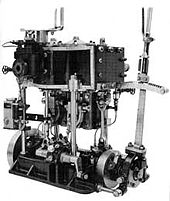Griffin (ship, 1895)
|
||||||||||||||
|
||||||||||||||
|
||||||||||||||
|
||||||||||||||
|
||||||||||||||
|
||||||||||||||
The Greif is the oldest and only hard coal -fired steamship with screw drive, which is still used today in public passenger shipping in Switzerland . It is part of the Zürcher Oberland industrial trail and traverses the Greifensee .
History of shipping on the Greifensee
In 1428 the mayor and the councilor of Zurich, Ruedy Meyer von Fällanden, gave the order to build a ship for 30 people in order to carry out transports for the governor of Greifensee free of charge and for others against payment. The connection across the lake, which mainly serves market and errands, was previously provided by rowing ships. However, with increasing industrialization, these were no longer sufficient.
In 1856 the Glattalbahn was built on the Usterersee side . Maur was in danger of being cut off from development.
In 1890 the steamship company for the Greifensee was founded. It issued shares for subscription. The steamer Delphin , built in 1868 and owned by the widow of Napoleon III. was bought. Steam shipping began with a dense timetable that took rail connections into account.
In 1892 the dolphin capsized completely overloaded and sank off Niederuster within a minute. The accident claimed four lives. The next day the ship was lifted and towed to Maur, where it was repaired. The dolphin was subsequently renamed the Möve and resumed operations. However, the frequency fell from 26,000 passengers in the previous year to less than 5,000 in the unlucky year. In order to save the existence of the steamship company, all that remained was to build a new ship.
History of the griffin
Due to the Niederuster shipwreck in 1892, the population's confidence in the dolphin waned . The shipping company decided to act. In 1895 she commissioned Escher Wyss in Zurich (the largest manufacturer of ships in Switzerland at the time) to manufacture a new, tailor-made ship. After a construction period of only three months in today's shipbuilding, the Greif arrived in Maur and went on its maiden voyage on October 12th.
Coal became scarce in 1914 after the outbreak of the First World War ; operations therefore had to be reduced and partially discontinued. Two years later the Greif was converted into a motor ship and received a Daimler gasoline engine . This made a machinist superfluous and the fuel became cheaper. Thanks to these savings, the company was able to return to the black. In 1968 the Greif was fitted with a Bedford diesel engine. In 1979, when a dredger was demolished on Lake Zurich, the ship's original steam engine was found.
It operated until 1986 as a temporary help for course trips and tours. In 1981, an appraisal by the cantonal preservation authorities confirmed that the ship and steam engine were worth protecting; two years later, the "Foundation for the Restoration of the Steamship Greif " was established.
The ship was taken over by the foundation in 1986. It was restored according to original plans by Escher Wyss in the Faul AG shipyard in Horgen and re-equipped with the original steam engine and a replica boiler. Two years later, after trial runs on Lake Zurich, the steamship was brought to Greifensee on August 3, 1988. The second maiden voyage took place on September 3 of the same year.
The ship is largely maintained, overhauled and looked after by volunteers from the foundation for the operation of the steamship Greif . It is used for sightseeing, evening and charter trips and operated by specially trained skippers and machinists.
literature
- Peter Surbeck, Charlotte Kunz, Fritz Lebert: The steamship Greif and the SGG. Verlag UsterInfo GmbH, 8610 Uster, ISBN 978-3-905647-03-7 .
- B / W images: The Greif steamship, symbol of Greifensee shipping, ISBN 3-905647-03-6 .
Web links
- The history of the DS Greif. Retrieved December 4, 2019 .


